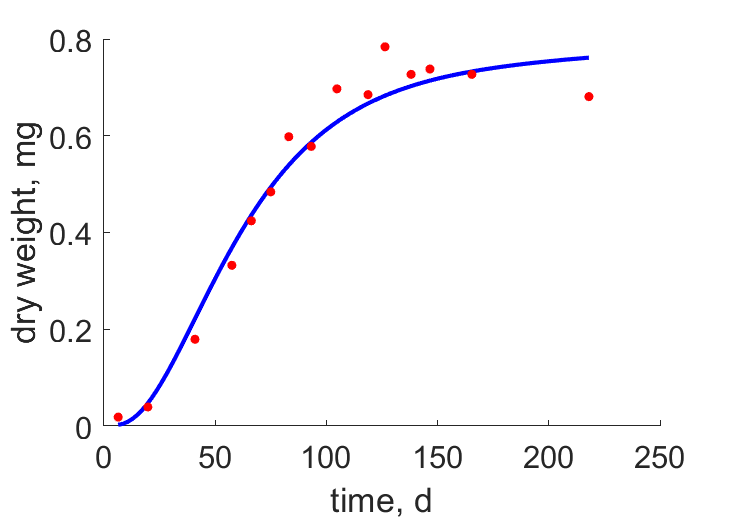Predictions & Data for this entry
| Model: hax | climate: Cfb, Dfb, Dfc | migrate: | phylum: |
| COMPLETE = 2.5 | ecozone: THn | food: bjCi | class: |
| MRE = 0.108 | habitat: 0eFl, 0eFp, 0eFm, eiTg | gender: D | order: |
| SMSE = 0.049 | embryo: Fs | reprod: Os | family: |
Zero-variate data
| Data | Observed | Predicted | (RE) | Unit | Description | Reference |
|---|---|---|---|---|---|---|
| ab | 2 | 1.856 | (0.07217) | d | age at birth | FedoSwif1972 |
| tj | 240 | 244.8 | (0.02014) | d | time since birth at pupation | FedoSwif1972 |
| am | 4 | 8.512 | (1.128) | d | life span as imago | chebucto |
| Lb | 0.2 | 0.1491 | (0.2545) | cm | length at birth | FedoSwif1972 |
| Lj | 1.6 | 2.132 | (0.3323) | cm | length at pupaption | FedoSwif1972 |
| Wd0 | 0.251 | 0.2961 | (0.1796) | mug | egg dry weight | Lehm1998 |
| Wdb | 0.006 | 0.0002485 | (0.9586) | mg | dry weight at birth | FedoSwif1972 |
| Wdj | 0.7 | 0.7263 | (0.03753) | mg | dry weight at pupation | FedoSwif1972 |
| Ni | 160 | 149.3 | (0.06718) | #/d | maximum reprod rate | FedoSwif1972 |
Uni- and bivariate data
| Data | Figure | Independent variable | Dependent variable | (RE) | Reference |
|---|---|---|---|---|---|
| tW |  | time | dry weight | (0.06675) | FedoSwif1972 |
Pseudo-data at Tref = 20°C
| Data | Generalised animal | Chaoborus americanus | Unit | Description |
|---|---|---|---|---|
| v | 0.02 | 0.007976 | cm/d | energy conductance |
| p_M | 18 | 706.6 | J/d.cm^3 | vol-spec som maint |
| k_J | 0.002 | 0.002 | 1/d | maturity maint rate coefficient |
| k | 0.3 | 0.01251 | - | maintenance ratio |
| kap | 0.8 | 0.9962 | - | allocation fraction to soma |
| kap_G | 0.8 | 0.8044 | - | growth efficiency |
| kap_R | 0.95 | 0.95 | - | reproduction efficiency |
Discussion
- Model hax was fitted, but little is known about pupal development
Facts
- C. americanus lives mainly as a larvea with 4 instar stadia (Ref: FedoSwif1972)
- At emergence it lives for a few more days without eating and lays eggs. In its larval stage it is benthic (Ref: Wiki)
- Chaoborus has a one year life cycle; body length of instar IV can grow from 9 to 12 mm. (Ref: FedoSwif1972)
- Chaoborus larva has modified antennae with which is can grap small prey, such as crustaceans, chironomid larvae, olichochaetes (Ref: chebucto, Wiki)
Bibliography